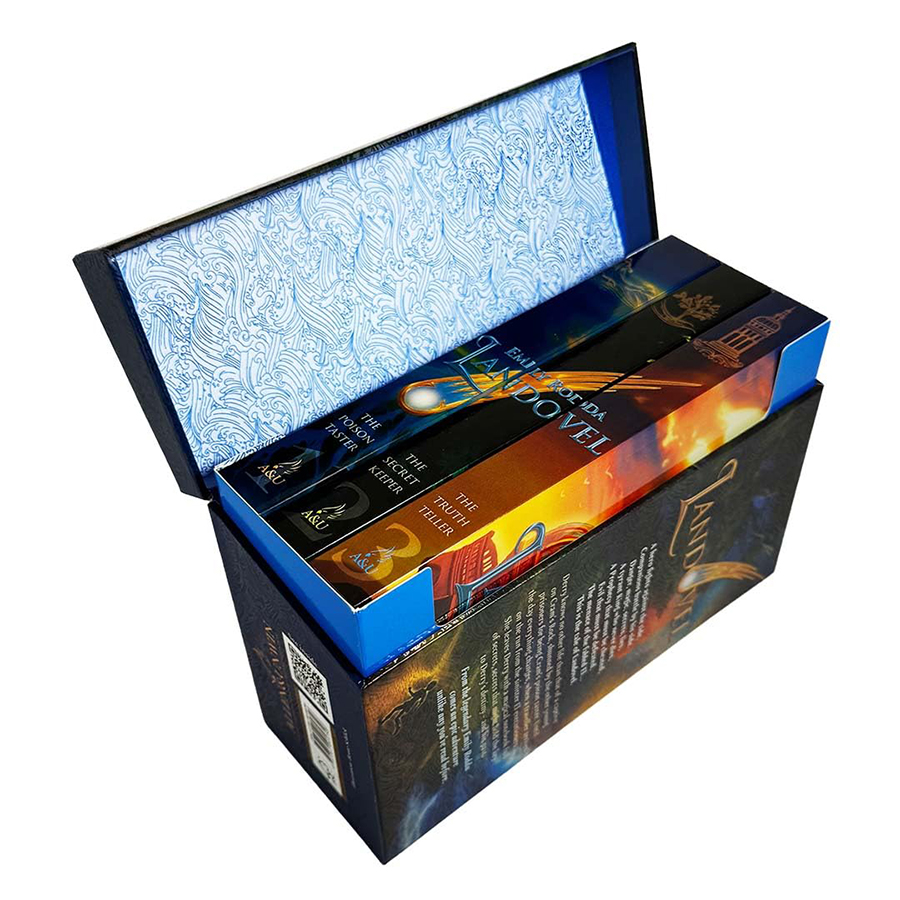
(Book covers for book 1-3 with distinguised color schemes showing important landmarks within the LANDOVEL world)
I chatted with Allen & Unwin about the unique challenges of illustrating the three book covers and the box for epic fantasy series LANDOVEL written by Emily Rodda.
Read below:
A&U: Hey Bente! Thanks so much for agreeing to speak with us. Can you start by telling us a little bit about yourself and your work as an illustrator and designer?
BS: Hi, I’m a freelance illustrator based in Hamburg, Germany, with nearly 15 years of experience in the industry. From my studio, I work with publishing houses and agencies around the world, illustrating a variety of children’s and young adult books but also working on concept art and illustrations for advertising agencies. My work has also been licensed globally for puzzles and various stationery products. While my main scope of work is fantasy, featuring magical creatures, imaginative worlds, and strong female characters, I’m always open to exploring a broad range of subjects in my illustrations.
A&U: How did you get involved with Landovel?
BS: I was approached by [editor] Kate Whitfield to illustrate the slipcase and book covers. I believe A&U may have discovered my work through other Australian publishers or perhaps from the German covers I created for Australian authors. I’m thrilled to have been a part of this wonderful project.
A&U: Can you tell us about the inspirations for the Landovel covers?
BS: A&U provided some samples of my existing work, which was helpful, but my overall inspiration came from the artwork and lighting techniques of old masters like William Turner, as well as the cinematography of films like The Lord of the Rings and shows like Game of Thrones. The design needed to be epic and dramatic, yet still appealing to younger people, so I incorporated bold, vibrant colors to create a sense of wonder and excitement.
A&U: What unique challenges did illustrating the Landovel covers present?
BS: The first challenge was illustrating three distinct book covers simultaneously, each featuring a unique color and scene, while maintaining a cohesive look across the set. This was especially tricky with elements like a tower on one cover and a tunnel on another, yet still needing to place the typography consistently. Initially, the typography was meant to be in the same location on each cover, which made it challenging to ensure the designs were still dynamic and visually engaging.
The second challenge was the slipcase, which required thinking in both 2D and 3D. I started with a rough sketch, positioning the type to guide the placement of elements. However, it was important that the composition felt “right” and plausible, with an appealing layout that also left enough space for the text. This meant creating light or dark areas that affected the objects within the scene. Once printed, the slipcase had to look cohesive, with the individual elements on the front, spine, and back cover all working together. Ultimately, the key was finding a balance where the editor’s requirements harmonized with the overall illustration.

(Landovel wrap around illustration for slipcase merging the landmarks from the individual book covers into one seamless landscape)
A&U: Can you tell us about your favourite part of the illustration process?
BS: I always feel excitement when starting the first concepts and sketches—researching, brainstorming, and letting ideas flow. My mind goes into overdrive, filled with inspiration. Then comes the satisfaction of adding the final touches, where each brush stroke brings the artwork closer to perfection. But the best part is holding the finished product in my hands, seeing all the hard work come together, and knowing it’s been executed well and the client is pleased too.
A&U: What is the best part about illustrating fantasy for you?
BS: What I love about fantasy is the limitless possibilities—it allows you to envision so much without boundaries. There are no strict rules for how things should look; you can invent your own „rules,“ create unique characters with specific costumes, imagine your own creatures, and design entire worlds. I enjoy painting freely, without needing to explain why I chose a certain subject or why something looks a particular way.
Working with clients on fantasy projects is equally exciting because each story comes with its own unique world-building, characters, and lore. It’s thrilling to dive into these new stories and create visuals for unknown worlds. Bringing written words to life, giving them a „face“ so to speak, feels like letting the characters and the story breathe—taking what’s in your imagination and shaping it into something real.
A&U: What advice would you give someone who wants to illustrate book covers one day?
BS: Think about what and how you want to illustrate. Visit your local bookstore and take a close look at the book covers, or attend a book fair to get a sense of what’s in demand. There’s no universal formula for how to break into the industry as an illustrator, whether for books or other projects. You need to discover your own unique style. It’s important to find a balance between what you want to create for yourself and what the market and clients are looking for at the time. My advice is to keep pushing forward and never give up, no matter how challenging it may feel.


This interviews was originally published at Allen & Unwin
